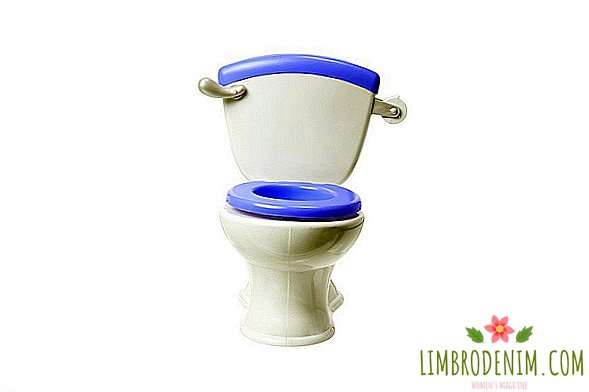The Untouchable: Can I Sit in a Public Toilet?
AMAZING NET PUBLIC TOILETSwhere there is a disposable paper seat and there are machines with tampons and pads, while more common in travel. In Russia, where for thirty rubles a strict watchman tears off twenty centimeters of toilet paper from a roll (or doesn’t tear, if not asked), any public toilet is a necessity, sometimes so unpleasant that a violation of decency (and in general the law) "under the bush "seems the lesser of two evils. To hygiene of public toilets, there are sometimes issues even in clean shopping centers, and it seems that there are many scary infections that can be picked up. We decided to find out what is really worth being afraid of, which is worse than a public toilet, and what to do to get out of there with a sense of relief, not panic.

Microbes and hands
The number of pathogenic bacteria that are concentrated in public toilets is so large that it is incalculable. It is logical that the public restroom in our perception is a hotbed of any infection, but this is not quite true. Naturally, there are many germs in the toilets, but mostly they are fecal bacteria - those that are found in the intestines. The main inhabitants of the toilets, according to microbiologist Philip Tierno, is E. coli (which feels great in your own intestines, but can cause escherichiosis with severe diarrhea, especially dangerous for children, and cystitis, if it can get into the urethra and above), Streptococcus and Staphylococcus aureus (which causes purulent infections if it finds appropriate conditions). Other common inhabitants of the toilets are salmonella and shigella (the latter causes dysentery), in some countries - the causative agents of hepatitis A. In general, it is most likely to catch an intestinal infection in the toilet, transmitted by the fecal-oral route.
But contact with these microbes does not mean that a person becomes ill immediately. In fact, people are permanent carriers of all these bacteria, and they are found not only in the toilet, but also in transport, on door handles and even on smartphones. The skin and mucous membranes work as a protective barrier, and it is quite reliable - if any bacterium could penetrate through it, we would simply have died out long ago. Of course, the concentration of pathogens in the toilet is higher than in a cafe - but this only means that after the toilet additional hygiene measures are required. You need to thoroughly wash your hands and not to grasp the door handles with clean fingers (because previous visitors could touch them with dirty ones); A good option is to treat your hands with an antibacterial gel or wipes after leaving the toilet. If the skin is not damaged and you do not touch your face or lips with unwashed hands, the chance of getting sick is not great.
Sitting or standing
Elena Malysheva was laughed at for a long time when she tried to teach the country to go to the toilet properly - and they laughed completely in vain. The fact is that hanging on the toilet in a half-sitting posture is half-sitting is harmful and non-physiological: the bowels are bent in a certain way so that a person cannot, for example, defecate while standing. Therefore, according to research, to successfully visit the toilet you need to sit down, and quite low so that your knees rise to your chest - then defecation will require less effort. And the less stress, the less hemorrhoids - in this case, in the literal sense of the word.
So low toilets in a public toilet - this is more of a plus than a minus. Therefore, if there is a relatively clean public toilet in front of you - for example, in a restaurant or a shopping center - and a cleaning schedule hangs on the wall, then it is better not to worry and land calmly to do your work.

Toilet bowl and lining
What if the fear of germs does not relax? It would seem that disposable toilet seats, which are in some toilets (or that can be carried around), should save the day. In extreme cases, such pads can be replaced with strips of toilet paper, paper towels or napkins.
Psychologically, it is much easier to overcome disgust in front of common areas, but in fact these seats do not protect from anything. William Schaffner of Vanderbilt University explained to The Huffington Post that toilet seats themselves are not a means of transmitting any infections. Touching the drain button and the door handles already mentioned is much more dangerous - and the flushing mechanism contributes to the spread of infection.
True, lining the toilet can help the skin. There is a rather rare syndrome - toilet dermatitis. Usually it occurs in children whose parents are too addicted to cleaning products and use aggressive household chemicals at home to clean the toilet bowls - and no one guarantees that they didn’t clean the public toilet with something as severe. Therefore, if you have a skin gentle and sensitive to household chemicals, it is better to put a disposable seat after all.
Button and spray
It is better to flush it behind you, having already closed the toilet lid - and if there is no lid, then it is better to try to move away and reach the drain button from a distance. Scientists approached the issue seriously and measured the number of pathogenic bacteria at different distances from the toilet after flushing. It turned out that dangerous germs that cause vomiting, diarrhea and other signs of an intestinal infection, when flushed, are thrown upwards by ten centimeters. Naturally, after that, they do not climb back into the toilet, and fly away to where it will turn out.
The question concerns not so much public toilets as domestic ones: if you have a combined bathroom and toothbrushes or makeup brushes are close to the toilet, it’s time to get into the habit of closing the lid when flushing.
As for public toilets, it is impossible to control who and how washes them behind them in the booths, except to fully automate the process, but this is unlikely to happen everywhere in the near future. Therefore, we must remember that the toilet "plume" of bacteria and viruses after flushing settles on all surfaces, and this was proven back in 1975. So, the less we touch something inside the booth, the better.
Putting a bag on the floor in a public toilet or putting a wallet is much more dangerous than sitting on the toilet. Everything is collected on the floor: the bacteria that scattered around the booth during the washout, and what the visitors brought on their shoes (up to the helminth eggs). If there are no shelves or hooks, and it’s impossible to hold everything in your hands, then the bottom of the bag is then better treated with napkins with an antiseptic - and try not to throw bags and bags at home on the bed.

STIs and rare infections
There is no doubt that the toilet is full of germs, but do not think that there are bacterial and viral monsters living that are resistant to all antibiotics in the world, or the causative agents of infections that are transmitted through sexual contact.
The fact is that the main carrier of pathogenic microbes that cause sexually transmitted diseases is man. They are transferred from one person to another through direct contact, and outside their natural environment they quickly die. Of course, it is possible to pick up a sexually transmitted infection in a public toilet — but only if you decide to have sex in a booth with a carrier of this infection and have not taken care of condoms.
Stand up to home
Suppose you are on a long bus ride - and finally there is a station where you can go to the toilet and stretch your legs a little. Sadly, there are still toilets on the roads, which are a structure of unplaned planks with a hole in the floor and spiders in the corner. In this situation, it seems that it is better to suffer a couple of hours.
Nevertheless, it is better not to wait for the shopping center to appear on the horizon, but, as far as conditions allow, to go to the toilet. Attempts to endure can lead to health problems. On the part of the intestine, this may be constipation or discomfort, and on the part of the bladder, an increase in the risk of developing infections and urinary problems in the future. It is better not to abstain from urinating for more than four hours in a row. In the end, it's just unpleasant and uncomfortable.
Main rules
Public toilets are different, but the basic rules are the same for everyone: first, you should not put bags on the floor, and especially go to the toilet with a glass of coffee with you. In addition, it is desirable to close the lid before flushing, so that the spray does not settle on you. Secondly, after visiting the toilet, you must wash your hands with soap and it is advisable to do this for at least a minute. Hands can be dried with a disposable towel or dryer - and close the tap or open the door is also better with a towel or napkin. Finally, if the toilet is very suspicious from the point of view of hygiene, after you leave the room, it will not hurt to treat the hands with gel or napkins with an antiseptic.
Photo:fotomatrix - stock.adobe.com, Elenathewise - stock.adobe.com, Jon Schulte - stock.adobe.com





